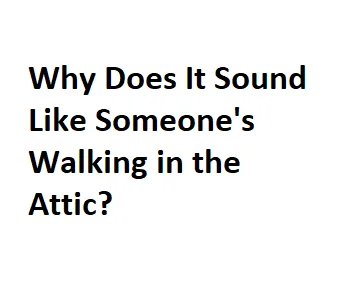The eerie sound of footsteps in the attic is a phenomenon that has perplexed homeowners for generations. The unexplained noises can range from subtle creaks to distinct footfall sounds, leaving many wondering if their home is harboring a mysterious presence. In this blog post, we’ll embark on a journey to unravel the mystery behind why it sounds like someone is walking in the attic.
1. House Settling and Structural Changes:
One of the most common explanations for mysterious attic sounds is the natural settling of a house. Over time, the materials that make up the structure of a home may shift and settle, especially in older houses. This settling can produce creaks, pops, and other noises that are often misconstrued as footsteps. Changes in temperature and humidity can also contribute to these structural sounds.
2. Wildlife Intrusions:
The attic, with its often undisturbed and insulated environment, can be an attractive haven for wildlife seeking shelter. Squirrels, rats, birds, or even bats may find their way into your attic, creating a cacophony of sounds as they scurry and move about. Conducting regular inspections and addressing any points of entry can help mitigate the chances of unwelcome animal guests.
3. Plumbing and HVAC Systems:
The infrastructure of your home, particularly plumbing and HVAC systems, can be a surprising source of sounds that resonate through the attic. The flow of water through pipes or the operation of heating and cooling systems can create audible noises that may be mistaken for footsteps. Regular maintenance and prompt repairs can alleviate these disturbances.
4. Thermal Expansion and Contraction:
The materials in your home, including those in the attic, expand and contract with temperature changes. This phenomenon, known as thermal expansion and contraction, can result in popping or cracking sounds. As the attic is often a space with less insulation, these noises may be more pronounced, adding to the perception of mysterious footfall.
5. Atmospheric Conditions:
Weather conditions and atmospheric changes can also play a role in the sounds you hear in your attic. Strong winds, changes in air pressure, and external noises may find their way into your home, creating the illusion of footsteps. Being mindful of external factors can help differentiate between natural occurrences and potentially paranormal experiences.
6. Electrical Issues:
In some instances, electrical issues within your home can contribute to mysterious sounds. Faulty wiring, electrical arcs, or the humming of electrical components can produce vibrations that resonate through the structure, including the attic. Regular electrical inspections and prompt resolution of any issues can help eliminate these potential sources of noise.
7. Loose or Expanding Insulation:
The insulation in your attic serves a crucial role in regulating temperature, but it can also be a source of sounds. Loose or expanding insulation, particularly during temperature changes, might create rustling or crackling noises. Ensuring proper installation and addressing any issues with insulation can help minimize these disturbances.
8. Foot Traffic from Above:
If your home has multiple stories, sounds from people walking or moving around on the floor above the attic can be transmitted through the structure. This is especially true if the attic has thin flooring or lacks proper soundproofing. Identifying the specific location of the sounds and understanding the structure of your home can provide clarity on this matter.
9. Psychological Factors:
Sometimes, what we hear in the attic may not have a physical source. Psychological factors, such as heightened sensitivity, stress, or a predisposition to interpreting sounds as footsteps, can contribute to the perception of mysterious noises. Being mindful of your own mental state and seeking the input of others in your household can help discern whether the sounds are real or perceived.
10. Structural Movements and Aging Materials:
As homes age, the materials used in their construction may degrade or undergo changes that result in audible sounds. Wood, for example, can contract and expand with fluctuations in temperature and humidity, leading to the creaks and pops that might mimic footsteps. Understanding the natural aging process of your home’s materials can provide insights into the source of attic sounds.
11. Construction and Renovation Residue:
If your home has recently undergone construction or renovation, residual materials such as sawdust, nails, or even small construction debris might be settling in the attic. As these materials shift or move, they can produce unexpected sounds. Ensuring a thorough cleanup after any construction work can help alleviate these issues.
12. Vents and Airflow:
The ventilation system in your home, including vents in the attic, can create airflow that produces sounds. Ducts expanding and contracting, air rushing through vents, or even the sound of wind passing through openings can contribute to the auditory puzzle. Regular maintenance and cleaning of ventilation systems can mitigate these potential sources of noise.
13. Settling Furniture or Belongings:
If your attic is used for storage, the sounds might be caused by the settling of furniture or belongings. Items shifting, expanding, or settling over time can create audible disturbances. Organizing and securing stored items can help minimize these occurrences.
Common Causes
| No. | Cause | Description | Signs | Solutions |
|---|---|---|---|---|
| 1 | Animal Infestation | Small animals like rodents or birds | Scratching sounds | Hire a pest control professional. |
| 2 | Structural Settling | Natural settling of the house structure | Occasional creaks | Monitor and consult with a structural engineer. |
| 3 | Temperature Changes | Expansion and contraction of materials | Popping sounds | Maintain consistent temperature and humidity. |
| 4 | Loose or Damaged Roofing | Loose shingles or damaged roofing materials | Periodic thumping | Inspect and repair the roof as necessary. |
| 5 | Wind or Atmospheric Conditions | External factors influencing sounds in the attic | Rattling or banging | Weatherproof the attic and seal any openings. |
Animal Infestation Types
| No. | Animal | Description | Behavior | Signs |
|---|---|---|---|---|
| 1 | Rats | Small rodents known for gnawing | Nocturnal activity | Droppings, scratching sounds |
| 2 | Squirrels | Agile mammals that can access attics | Daytime activity | Scratching, scampering noises |
| 3 | Birds | Feathered creatures seeking shelter | Flapping wings | Bird droppings, chirping sounds |
| 4 | Bats | Nocturnal flying mammals | High-pitched squeaks | Rustling or fluttering sounds |
| 5 | Insects | Crawling insects seeking refuge | Soft tapping or buzzing | Presence of insects, nests |
Structural Issues
| No. | Issue | Description | Signs | Solutions |
|---|---|---|---|---|
| 1 | Foundation Problems | Issues with the base of the house | Uneven floors, cracks in walls | Consult with a foundation repair expert |
| 2 | Settling of Beams and Joists | Natural settling of load-bearing components | Creaking sounds, minor vibrations | Reinforce or replace affected components |
| 3 | Insufficient Support | Lack of proper structural support | Sagging ceilings, unusual sounds | Consult with a structural engineer |
| 4 | Water Damage | Moisture-related damage affecting materials | Mold growth, weakened structures | Repair water damage and address leaks |
| 5 | Poor Construction | Shoddy construction leading to issues | Unstable structures, uneven floors | Renovate and reinforce as necessary |
Weather-Related Factors
| No. | Weather Condition | Description | Impact on Attic | Prevention Measures |
|---|---|---|---|---|
| 1 | Heavy Rain | Intense rainfall causing noise | Dripping sounds | Ensure proper attic insulation and drainage |
| 2 | Windy Conditions | Strong winds impacting the roof structure | Whistling or rattling | Reinforce roofing materials and seal openings |
| 3 | Temperature Changes | Fluctuations causing materials to expand | Popping or creaking | Maintain consistent temperature and humidity |
| 4 | Hailstorms | Ice pellets hitting the roof | Loud banging sounds | Install impact-resistant roofing materials |
| 5 | Snow Accumulation | Weight of snow on the roof | Creaking or cracking | Remove excess snow and ensure proper insulation |
Maintenance and Prevention
| No. | Preventive Measure | Description | Frequency | Additional Tips |
|---|---|---|---|---|
| 1 | Regular Inspections | Systematic checks for signs of issues | Biannually or quarterly | Address issues promptly to prevent escalation |
| 2 | Pest Control | Professional inspection and removal of pests | Annually | Seal potential entry points and gaps |
| 3 | Roof Maintenance | Regular checks for loose shingles and damage | Annually | Repair minor issues before they escalate |
| 4 | Structural Integrity Checks | Monitoring for any signs of structural problems | Biannually or as needed | Consult with experts for professional advice |
| 5 | Weatherproofing | Ensure the attic is properly sealed and insulated | As needed | Improve insulation and seal any openings |
Conclusion:
In the pursuit of uncovering the truth behind the mysterious sounds in the attic, a comprehensive examination of various factors is crucial. Structural movements, construction residue, ventilation systems, and even the natural aging of materials all play a role in creating sounds that may be mistaken for footsteps.
By taking a systematic and open-minded approach to investigating these noises, homeowners can dispel the sense of mystery and proactively address any underlying issues. If uncertainty persists, enlisting the expertise of professionals—from contractors and pest control specialists to sound engineers—can provide the final pieces of the puzzle.
Ultimately, understanding the diverse array of factors contributing to attic sounds transforms the eerie into the explainable, fostering a sense of peace and assurance within the home.

